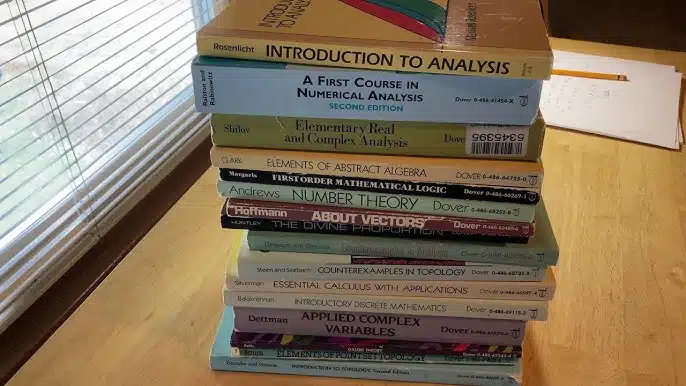Mathematical analysis is a branch of math. It studies functions, limits, continuity, and the properties of real numbers. It is fundamental for students pursuing advanced mathematics, engineering, physics, and related fields. Whether you’re a beginner or advanced, the right resources are crucial for mastering this tough subject. This article will explore the best books on mathematical analysis. We’ll cover both introductory and advanced texts for deeper study.
10 Best Books for Mathematical Analysis:
- “Principles of Mathematical Analysis” by Walter Rudin
- “Understanding Analysis” by Stephen Abbott
- “Introduction to Real Analysis” by Robert G. Bartle and Donald R. Sherbert
- “Real Analysis: Modern Techniques and Their Applications” by Gerald B. Folland
- “Elementary Analysis: The Theory of Calculus” by Kenneth A. Ross
- “Mathematical Analysis” by Tom M. Apostol
- “Real Analysis” by H.L. Royden and P.M. Fitzpatrick
- “Analysis I” by Terence Tao
- “Introduction to Analysis” by Edward D. Gaughan
- “A Course in Real Analysis” by Neil A. Weiss
Detailed Descriptions of the Best Books for Mathematical Analysis:
“Principles of Mathematical Analysis” by Walter Rudin
- Overview: Often referred to as “Baby Rudin,” this book is a classic in the field of real analysis. It is widely regarded for its rigorous approach and clarity. Rudin’s work is a staple for many in mathematical analysis, and its Best Book Acknowledgements often highlight the influences and mentors who shaped this seminal text, offering valuable insight into the author’s journey and the research behind the book.
- Why It’s Great: The book covers basics like sequences, series, and continuity. Its exercises challenge readers to think critically. It’s suitable for those who have a solid foundation in calculus and are ready for advanced concepts.
“Understanding Analysis” by Stephen Abbott
- Overview: Abbott’s book is a friendly intro to analysis. It’s for readers new to real analysis. It presents the material in a less formal, more accessible style compared to Rudin’s work.
- Why It’s Great: The book values intuition and understanding. It is perfect for those who want to grasp the basics before tackling complex theories. It’s filled with helpful examples and exercises that make learning more manageable.
“Introduction to Real Analysis” by Robert G. Bartle and Donald R. Sherbert
- Overview: This book clearly introduces real analysis. It focuses on sequences, series, and functions of real variables. It’s often recommended for undergraduate students.
- Why It’s Great: The text strikes a balance between theory and applications. Its clarity and exercises make it a great starting point for students moving from calculus to real analysis.
“Real Analysis: Modern Techniques and Their Applications” by Gerald B. Folland
- Overview: Folland’s book is more advanced. It covers real analysis, focusing on modern techniques. It’s suitable for graduate-level students or those with a strong mathematical background.
- Why It’s Great: It covers measure theory, integration, and functional analysis. It emphasizes abstraction and generalization.
“Elementary Analysis: The Theory of Calculus” by Kenneth A. Ross
- Overview: Ross’s book is a great resource for beginners. It offers a clear, accessible intro to real analysis.
- Why It’s Great: The book’s focus on basic calculus is superb. It’s a great resource for beginners in mathematical analysis.
“Mathematical Analysis” by Tom M. Apostol
- Overview: Apostol’s book is known for its thorough and rigorous treatment of analysis. It starts with basics and moves to complex topics. So, it suits both beginners and advanced learners.
- Why It’s Great: Apostol’s methodical approach and exercises build a strong grasp.
“Real Analysis” by H.L. Royden and P.M. Fitzpatrick
- Overview: This book is often used in graduate courses. It covers measure theory, integration, and functional analysis.
- Why It’s Great: It explores the theory behind real analysis. It’s perfect for students who have mastered the basics and seek advanced study.
“Analysis I” by Terence Tao
- Overview: Tao’s book is part of a series that explores the foundations of real analysis. It provides a modern approach to analysis, suitable for undergraduates and graduate students.
- Why It’s Great: Tao’s writing is clear and easy to read. The book has many exercises to help readers understand the subject.
“Introduction to Analysis” by Edward D. Gaughan
- Overview: Gaughan’s work is an intro to real analysis. It emphasizes understanding concepts, not memorizing proofs.
- Why It’s Great: The book is a great, accessible intro to real analysis. It is often recommended for a more intuitive approach.
“A Course in Real Analysis” by Neil A. Weiss
- Overview: Weiss’s book is an advanced intro to real analysis. It covers the structure of real numbers, continuity, and the fundamental theorem of calculus.
- Why It’s Great: The book is thorough. It provides a solid base for those wanting to study analysis at a higher level.
FAQs about the Best Books for Mathematical Analysis
What is mathematical analysis?
Mathematical analysis is a branch of math. It focuses on limits, continuity, sequences, series, and the properties of real numbers. It is foundational for advanced study in many areas of mathematics and science.
Which book is best for beginners in mathematical analysis?
“Understanding Analysis” by Stephen Abbott is often recommended for beginners. It has a clear, intuitive approach to the subject.
Is “Principles of Mathematical Analysis” by Walter Rudin suitable for beginners?
“Principles of Mathematical Analysis” by Walter Rudin is highly regarded. But, it is advanced and may challenge beginners. It is better suited for students who already have a solid understanding of calculus.
What is the best book for advanced mathematical analysis?
“Real Analysis: Modern Techniques and Their Applications” by Gerald B. Folland is a great choice for advanced students. It covers complex topics like measure theory and functional analysis.
Conclusion
Mathematical analysis is a key area of math. The right textbook can greatly affect your learning. The above books suit both beginners and advanced users. They offer a range of approaches, from intuitive to rigorous, advanced treatments. The right book depends on your understanding. Each resource will deepen your appreciation for the beauty and complexity of math.

